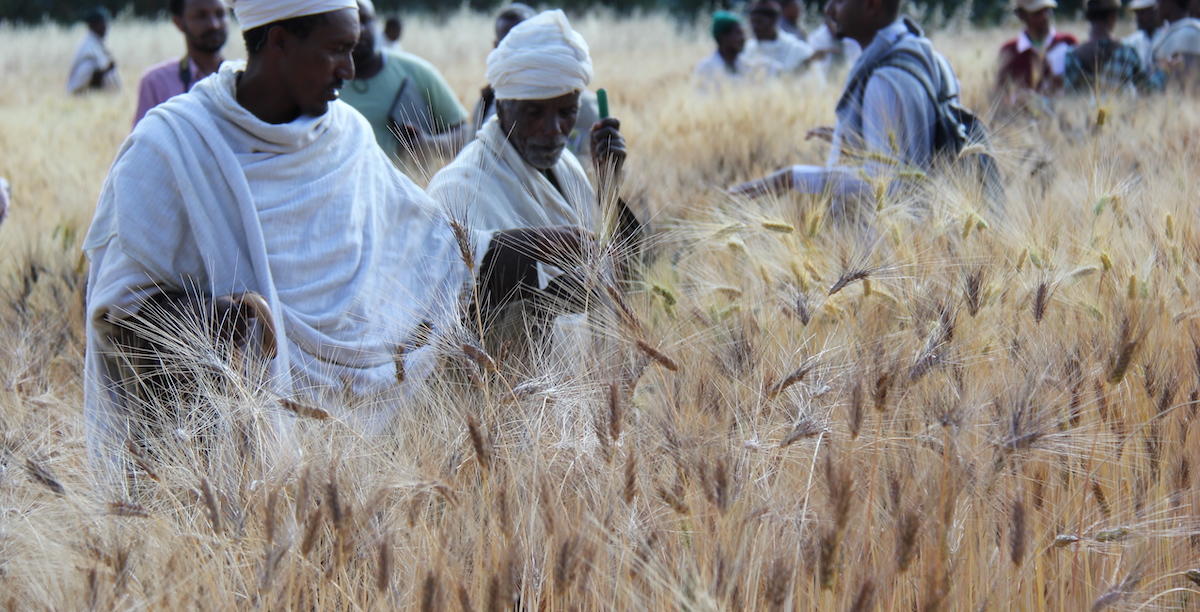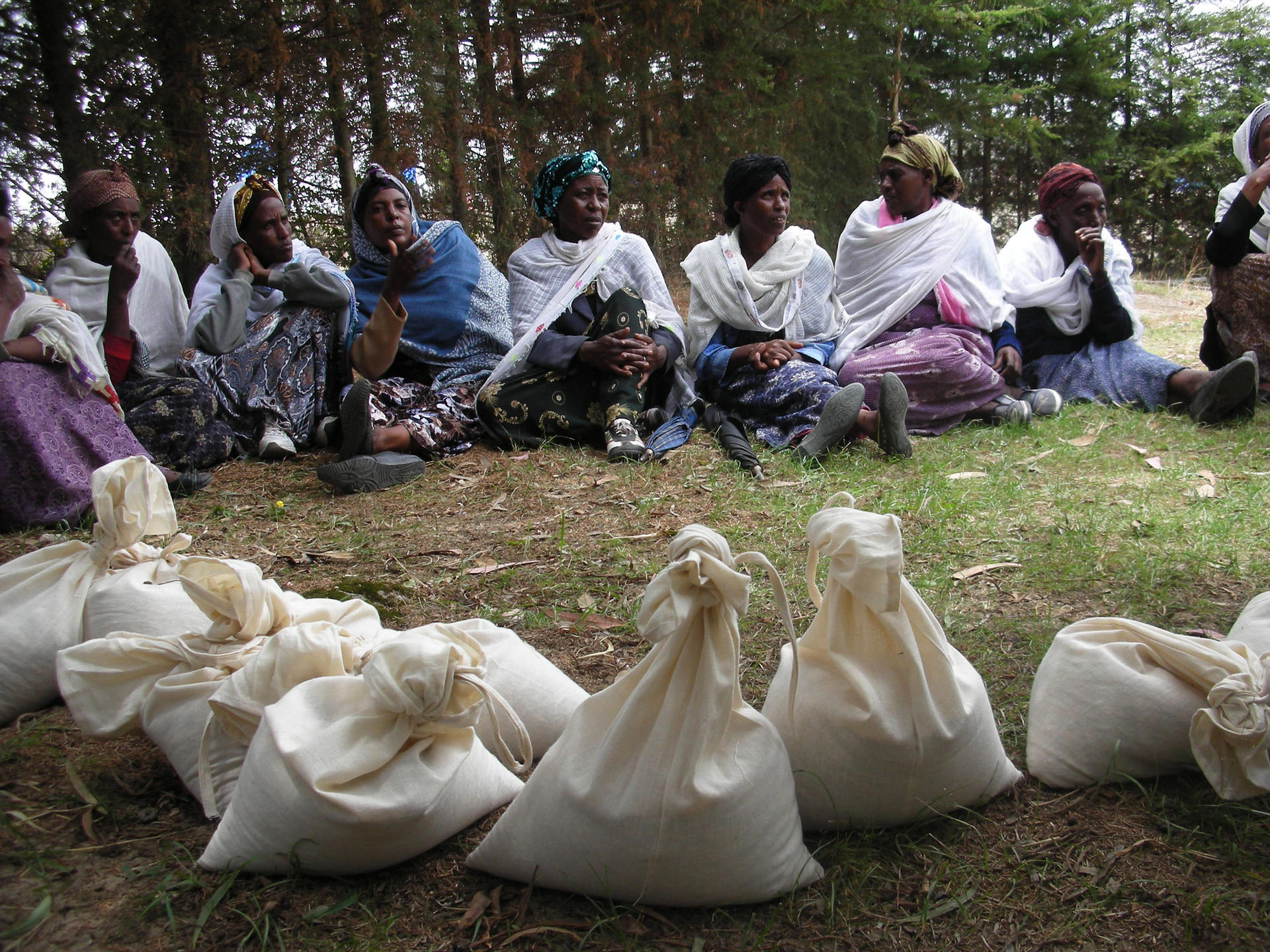Research Articles How to climate-proof the Ethiopian breadbasket? Combine genomics and farmer knowledge

Durum wheat is an important staple crop and part of Ethiopia’s cultural heritage. Its genetic diversity also holds clues for climate smart agriculture, according to a collaboration between researchers and farmer citizen scientists.
Diverse wheat matters
Ethiopia is one of Africa’s major wheat producing countries. But it might surprise you to learn that conventional bread wheat (Triticum aestivum, the most common species produced worldwide) only entered the country in the 1940s. For the previous 5000 years, Ethiopian agriculture had counted on a myriad of durum wheat varieties (Triticum turgidum ssp. durum, the closely related species ideal for making pasta), which are still consumed in many ways. “Durum wheat is culturally important in Ethiopia to make malt for local beer ‘tella’, homemade bread (‘difo dabo’), ‘kitta’ (unleavened bread), ‘nifro’ (boiled whole grain), ‘kollo’ (roasted whole grain mainly used as a snack), and ‘Kinche’, a form of porridge,” explains Cherinet Alem Gesesse, a plant geneticist from the Amhara Regional Agricultural Research Institute (ARARI).
Beyond their cultural significance, this agrobiodiversity has significant implications for the future of agriculture. “Having evolved under natural and artificial selection for thousands of years, these varieties are very well adapted to Ethiopia’s climate and soils,” says Carlo Fadda, Principal Scientist at the Alliance of Bioversity International and CIAT. "They are resilient to climate change and important assets for future production.”
Already grappling with drought and soil degradation, Ethiopian farmers know that they cannot rely on a single type of wheat, bred solely with productivity in mind. Matteo Dell'Acqua, a plant geneticist from the Scuola Superiore Sant’Anna, has been working with Ethiopian farmers to devise new ways to permanently integrate their knowledge in the agricultural innovation process. He says that farmers are searching at the varietal level for useful traits:
“Farmers look at what they see in their own fields, which may be different from breeding programs’ expectations due to specific environmental, cultural and management conditions. They select varieties with better adaptation to local uses and cropping.”

Durum wheat varieties growing in Ethiopia. Alliance of Bioversity and CIAT.
From farm, to genebank, and back to farm
But farmers are often forced to make trade-offs: for example, opting for varieties that are more likely to survive until harvest time, but that are less productive. They also have to make selections based on a limited pool of diversity. “A lot of agrobiodiversity is maintained in genebank collections collected over the years from farmers’ fields, but that are not easily accessible to them. Farmers living further away have limited opportunities to share seeds and experiences,” notes Dell'Acqua.
To strike a balance between adaptation and use, the researchers have looked inside Ethiopian genebanks to unlock the “broad genetic variations which may substantially contribute to future crop improvement,” as Gesesse puts it. They crossed Ethiopian traditional durum wheat varieties with international breeding lines, producing 1200 new genetic materials.
“We are trying to mix up the genetic factors to produce new combinations that have never existed before, and which may be used by farmers,” says Dell’Acqua.
These varieties were evaluated by groups of men and women farmers in a large-scale assessment in field trials in Ethiopia. Farmers’ preferences and feedback were quantified and compared with agronomic measures of crop performance, including yield, and were used in combination with DNA sequencing of wheat varieties to build performance prediction models. In their latest paper, the researchers showed that farmer evaluations can efficiently predict wheat yield and intend to use the data generated by these “citizen scientists” to inform selection and breeding moving forward. In the words of one reviewer:
“I find the result mind-blowing that genomic selection model using farmers' overall appreciation had a higher prediction accuracy over grain yield, than the model trained on grain yield itself.”

Ethiopian farmers participating in previous field trials. Alliance of Bioversity and CIAT.
Farmers selecting for the future
“Farmers’ knowledge is a scientific quantity that can contribute to breeding outcomes,” reflects Dell’Acqua. “This is not to say that farmers should replace breeders and scientists; we think that these data-driven methods can help capture the complexity of the real world and factoring it in breeding decisions that are targeted to user needs. Farmers can be a complement of this process. Their full integration would not only benefit the selection of most appropriate varieties, as we show in this paper, but would also serve to foster an appropriate recognition of farmer communities and of cultural heritage in producing better agrobiodiversity and sharing it in the wider world for the benefit of humanity.” Concludes Fadda:
“Africa is rich in agrobiodiversity: with species, varieties, and associated traditional knowledge. This study shows that in order to achieve accelerated resilience and sustainability in agriculture, both African crops’ genetic diversity and associated knowledge must be mainstreamed in agricultural research and development strategies.”
